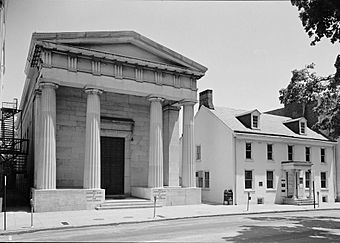Bank of Chester County facts for kids
Quick facts for kids |
|
|
Bank of Chester County
|
|
|
U.S. Historic district
Contributing property |
|

Bank of Chester County, HABS Photo, June 1958
|
|
| Location | 17 N. High St., West Chester, Pennsylvania |
|---|---|
| Area | 0.093 acres (0.038 ha) |
| Architect | Walter, Thomas U. |
| Architectural style | Greek Revival |
| NRHP reference No. | 02001458 |
| Added to NRHP | June 5, 1972 |
The Bank of Chester County is a really old and important building in West Chester, Pennsylvania. It was the very first bank to open in Chester County! This two-story building looks like an ancient Greek temple. It was built in the Greek Revival style. It has a grand entrance with four big columns.
You might also hear it called the National Bank of Chester County or Fidelity Bank. Back in the early 1800s, states started taking charge of how banks worked. Pennsylvania decided to allow many new banks to open. The Bank of Chester County was one of them. It was designed by a famous architect named Thomas Ustick Walter and finished in 1836. Today, the building is used by Wells Fargo. It was added to the National Register of Historic Places in 1972. This means it's a special historic site.
Contents
How the Bank Started
After the main bank in the United States closed in 1811, states got to decide how banks would work. In Pennsylvania, lawmakers wanted to create new banks. The governor at the time, Simon Snyder, first said no to a plan for 25 banks. But in 1814, a new plan for 41 banks was proposed. The governor said no again, but this time, the lawmakers voted to make it happen anyway!
This meant that Chester County could have its own bank. People could buy shares, which are like small pieces of ownership in the bank. Each share cost $50. The Bank of Chester County was then officially started in 1814.
Early Bank Buildings
The first home for the Bank of Chester County was in the Record Office. This building was at the corner of High and Gay Streets in West Chester, Pennsylvania. A few years later, in 1818, the bank bought a building across the street. This building, at 13 High Street, was built in 1792. The bank used this building for many years. They made changes to it over time to fit their needs.
In 1835, the bank decided to build a brand new, bigger home. This is the building we see today at 17 High Street. It was designed by the famous architect Thomas Ustick Walter. The new bank building was finished in 1836 and opened in 1837. It cost $33,000 to build. The stone used for the building came from a local marble quarry. The old bank building is still owned by the bank. It's used to store old equipment and has been rented out to different people over the years. Until 1857, the Bank of Chester County was the only bank in the entire county!
Changes Over Time
The bank changed its name a few times over the years. In 1864, it became the National Bank of Chester County. This was to follow new federal laws about banks. In 1930, it changed again to the National Bank of Chester County and Trust Company. On June 5, 1972, the building was officially added to the National Register of Historic Places. By 1987, it was known as Fidelity Bank. Today, Wells Fargo owns and operates the building.
Building Design
The Bank of Chester County building was designed in the Greek Revival style. It measures about 45 feet (14 m) wide and 90 feet (27 m) long. The bottom part of the building is made of high-quality stone. The walls are made of marble, covered with bricks. The front entrance has four tall Doric columns. These columns make the building look like an ancient Greek temple.
The building only has one main door at the front. The walls on the north and south sides were rebuilt in 1928 during a renovation. Some of the original windows on these walls were kept. The roof is covered with copper.
Inside the Bank
The inside of the bank has changed a lot over the years. When it was first built, the main banking room was smaller than it is now. There were two vaults near the entrance. These were later turned into offices. Some rooms at the back of the bank were also removed.
The original design had marble on the walls, keeping with the Greek style. In 1854, an artist named Carl Stromberg painted the ceiling blue. He also painted "leaves, fruit, and flowers" on the edges of the walls. Other walls had murals with landscapes. In 1863, a statue of William Darlington was placed in the bank.
The building has been renovated several times. These renovations happened in 1874, 1905, and 1928. In 1874, the inside was completely redesigned. New safes and more vaults were added. Even though the building used to have fireplaces for heat, it is now powered by electricity. None of the original floors, doors, or hardware are still there.


